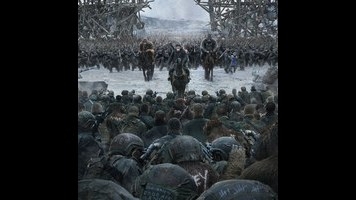The motion-captured ape characters are the bleeding edge of digital effects, rarely short of impressive. (All the technical wizardry in Hollywood still can’t render a believable puff of breath vapor, however.) They are also very sympathetic, especially Caesar’s orangutan advisor, Maurice (Karin Konoval), who takes a shine to a human moppet (Amiah Miller) he finds hiding in the back of a shack, and the poignant Bad Ape (a scene-stealing Steve Zahn), a mangy chimp who was beaten so often in his zoo-animal days that he came to believe what his handlers were shouting was supposed to be his name. The latter is discovered by Caesar, Maurice, and their compadres living in a crumbling, snow-packed ski lodge, its antler chandeliers hung with boogers of ice in a mockery of humanity’s pretensions of alpha-predator-hood. The apes aren’t us—until, of course, they are, as the movie buckles under the pressure of its self-consciousness. Like the recent Kong: Skull Island, it’s a half-hearted allegory for the Vietnam War, the war that has to stand in for all wars, because it’s the only one that American culture has deigned it okay to hate on; and like Logan, it’s a stealth Western passing itself off in a more marketable genre, with Serkis, the Lon Chaney of mo-cap, playing the graying, gun-slinging Caesar as an obvious, grimacing impression of Clint Eastwood circa The Outlaw Josey Wales.
It’s in this horse-opera mode that War For The Planet Of The Apes finds its most rewarding rhythms: in the parallels between Caesar’s woodland stronghold and the archetypal frontier settlements of Western fiction; in the ape posse, bent on vengeance, traversing landscapes clothed in snow and bristling with California red fir and silver pine, spooking human stragglers, and running across fresh graves as they search for the nameless colonel and try to piece together why the humans are killing each other. (The answer, as it always is in these things, is that it’s in our nature.) Through their inquisitive, furrowed gaze, we discover a ruined future. But the movie can’t escape that curse endemic to big-budget Hollywood sci-fi movies: The worlds they create on screen are almost always exponentially more interesting than the stories they tell. And this one ends up being betrayed by its homages to Apocalypse Now (there’s an “Ape-ocalypse Now” scrawled on a dilapidated wall at the midpoint, just in case viewers missed the other references), Schindler’s List, The Great Silence, and other classics; the sum of their ambitions can’t help but cast the formulaic, over-extended wartime prison-break that is War’s third act in an unflattering light.
There is a kind of self-reflexive futility that has been part of the Planet Of The Apes brand ever since Heston’s astronaut uselessly beat his fists against the ocean surf while cursing the twisting ending of the 1968 film; a less interesting character here than in the previous two films, Caesar glowers through the movie, as though aware that he has been condemned to a script that is rushing to clear the stage for the straightforward Planet Of The Apes remake first teased in Rise Of The Planet Of The Apes. (For those who wondered how humanity could lose most of the markers of civilization within the new prequels’ drastically shortened time-frame, War at least provides a somewhat inspired explanation.) It might just be too much for one talking-chimp movie to bear. But at least Reeves has some bona fide skills behind the camera. With its empty backdrops—big abandoned interiors, wide-open white spaces—War tests the sense of staging that Reeves has developed through his résumé of better-than-they-should-be projects (Cloverfield, the Let The Right One remake Let Me In, the aforementioned Dawn Of The Planet Of The Apes), which remains stronger than his sense of scale.
After some unnecessary, producer-pleasing expository text, he opens the movie in close-up on the back of a camo combat helmet Sharpied in Vietnam-style graffiti, effectively embedding the viewer with a bedraggled squad of human soldiers—armed with assault rifles, sawed-off shotguns, and crossbows—as they inch toward the stake-wall of Caesar’s compound in an attempt to bust through, only to be met with deadly clumps of Amazonian arrows and smoky flung projectiles. There’s a similar level of craftsmanship on display in a subsequent nighttime raid on the stronghold and in the movie’s darkest and most Spielbergian sequence, in which the apes are forced to strangle one of their own while trying to keep quiet in a human encampment—not to mention the confidence with which Reeves directs shot/reverse shot dialogue scenes between largely non-verbal, digital creations. This fundamental artistry is rarer than it should be, and it goes a very long way. But the end result is too boxed in by the demands of the franchise era and the usual restrictions of a PG-13 rating to qualify as art. It can’t show morally troubling violence or embrace hopelessness, and its day trip into the heart of darkness has to end with a ray of sunshine—“The horror, the horror…” in quotation marks.
